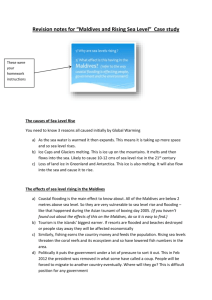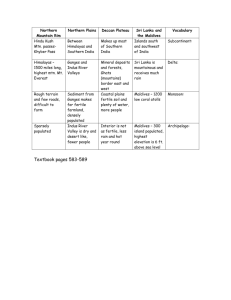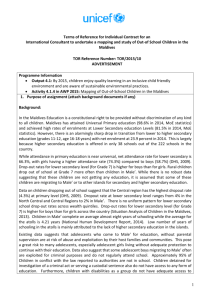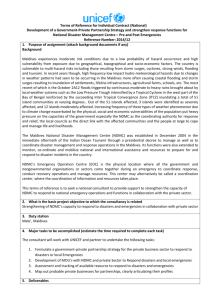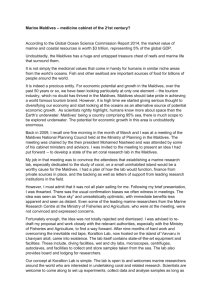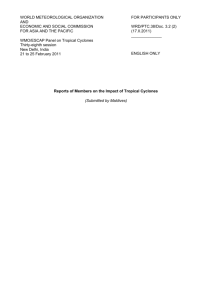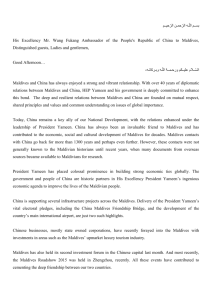Severe weather forecasting
advertisement
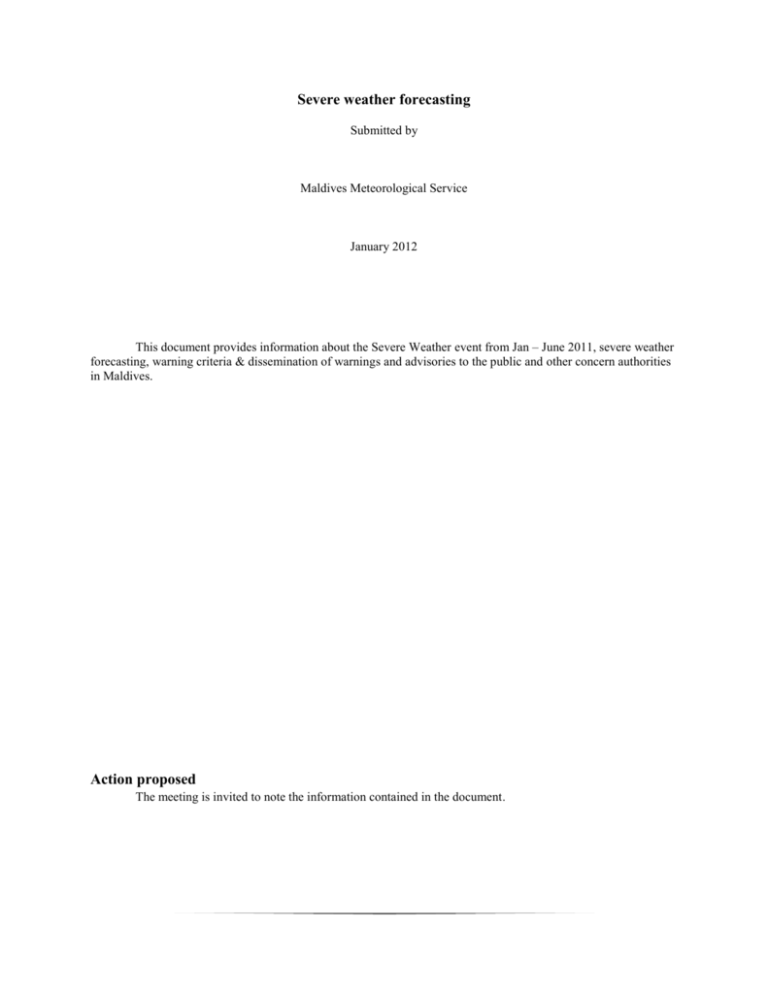
Severe weather forecasting Submitted by Maldives Meteorological Service January 2012 This document provides information about the Severe Weather event from Jan – June 2011, severe weather forecasting, warning criteria & dissemination of warnings and advisories to the public and other concern authorities in Maldives. Action proposed The meeting is invited to note the information contained in the document. Table of Contents Contents Page No 1.0 Introduction 1 2.0 Data and Methodology 2 3.0 Results and discussion 4 3.1 Severe weather event from Jan – June 2011 5 Annex 1. Interpreting Model forecasts 6 Annex 2. The criteria for issuing weather advisories and warnings 7 Annex 3: Warning Dissemination 7 6.0 8 References 1.0 Introduction The Republic of Maldives is an independent Island nation in the Indian Ocean south of Sri Lanka which stretches south to north in the Indian Ocean from 07° 06´N to 00° 42´ S. The land area of this Island country is about 300 km and none of Maldives’ 1192 Islands has elevation more than 2.5 m above sea level. It is basically the monsoons that dominate the climate of Maldives. The south-west monsoon or “hulhangu” from May to November is the wet season. Rough seas and strong winds are common during this period. May and October records the highest average monthly rainfall. The northeast monsoon “iruvai” falls between Januarys to March. This is a period of clear skies, cooler nights and slight seas. April and December are considered as transitional months. (DoM, 2004).The months of March and April are the hottest with April bringing in calm showers and windless days. However, strong winds and rain starting in April till May usually mark the change in seasons. Since Maldives is situated on the Equatorial belts, Maldives climate is usually warm throughout the year but also dotted with mild monsoons. The accurate geographical location of Maldives also saves the country from severe tropical storms and cyclones most of the time. However the rainfall in the country is affected due the following reasons. (1) The general monsoon conditions and movements of the Inter Tropical Convergence Zone with embedded disturbances and frequency of ‘freak storms’. Local storms: Maldives is affected by severe local storms which are thunder storms/thunder squalls, locally known as ‘freak storms’. Sometimes, storms accompanied with rainfall and high waves affect the southern parts of the islands during April and December, which is the interim period between the northeast and southwest monsoon seasons. The ‘freak storms’ affect the islands throughout the year with peak seasons during May to July. Even though the islands of Maldives are less prone to tropical cyclones, the northern islands of the country were affected by weak cyclones that formed in during the months of October to January. Whenever cyclones form in the Bay of Bengal or in the Arabian Sea, the spiraling clouds of the weather systems appear over the Maldives causing spells of rain. In this paper an attempt has been made to study the severe weather activities between Januarys to June 2011. Also an attempt has been made to measure the capability and the accuracy of NWP products to predict severe weather over the Maldives during the above mentioned period. 1 2.0 Data and Methodology The data used in this study is daily rainfall for the period from Jan to June 2011. The basic rainfall data obtained from the National Meteorological Centre, Maldives Meteorological Service. The data from five synoptic stations with each of them having 24 hours record utilized for analysis. The data used from five synoptic stations are shown in the following tables. The name of the stations and their respective geographical parameters are summarized in Table 1. Table: 1 List of synoptic stations of Maldives Stations Latitude Longitude Hanimaadhoo 06.75°N 073.17°E Hulhul'e 04.19° N 073.53 E Kadhdhoo 01.86°N 072.10°E Kaadehdhoo 00.49°N 072.10°E Gan 00.69° S 073.16 E 2 3 3.0 Results and discussion Severe Weather Events from January – June 2011 January, February and March are marked as dry season having significantly with few severe weather activities. Among the rain activities, a very first rain activity in January was due to a low level circulation formed over the East of Maldives close to Sri Lanka on 1 st of January. Under the influence of this system scattered rain showers occurred over the country. Among the severe weather activities in January, one of the most severe thunderstorms with heavy rain occurred in central atolls on 27th January. It was reported that 75 millimeters of rainfall recorded at the National Meteorological Centre and also lightning has struck two persons from Giravaru Island at Kaafu atoll and seriously injured during a thunderstorm. The two persons were taken to IGM hospital and were given treatment for the serious injuries caused due to the lightning incident. This incident happens when they were catching fishes from the reef on 27th January at 1130 hours. This disturbance was started due to a formation of a low-level wind convergence and also due to the convective cells developed by the local effect. The above effects has intensified further and formed a low-pressure trough over the Maldives on 28th. 4 The most intense disturbance within the month of January was on 31st which brought 102 millimeters of rainfall at the Gan (island) reported by Meteorological Office, Gan (island) Addu Atoll . This disturbance started on 28th and continued till 2nd February. It is reported that some islands at southern most atolls was flooded and reported damages of household goods due to heavy rain. Almost fine weather prevailed over the country till the last week of February. However a low pressure area formed on 24th February at the southern most atolls caused scatters rain and thunderstorms. Another low pressure trough has formed over the Maldives on 5 th March and continued till 9th March. Under the influence of the system, scattered thundershowers occurred over the country with isolated heavy showers in southern atolls. The heaviest down pour of 82 millimeters recorded in Gan on 5th March. The month of April is lying under the last phase of dry season in Maldives. It was noted that the first half of the month, the country as a whole experienced dry weather with a limited amount of rainfall. However the lowpressure trough formed over the Maldives on 18th April caused thundershowers to the country with occasional heavy showers in southern atolls. Heaviest down pour of 86, 62 and 69 millimeters recorded in Gan on 18 th, 25th and 27th of April respectively. Further, the ongoing severe weather conditions prevalent in southern atolls have caused flooding in some islands of Addu city with water seeping into the houses. The reversal of wind direction and wet spells for consecutive three days is considered to be the initial signs of onset of south west monsoon over the Maldives. From the last week of April onwards some of the onset signs appeared in southern atolls. Which include, on 30 th April the wind direction has changed to south-westerly direction and from 6th May, the southern parts of Maldives received rainfall greater than or equal to one millimeter for consecutive three days. Since the onset takes place from south to north, this year the south-west monsoon was onset on 6th May. This onset date was 11 days prior to its normal date of 17 May. After the establishment of south-west monsoon in southern atolls, on 23rd May the south-west monsoon became moderate over southern atolls and its associated rainfall was progressing northward gradually. Heaviest rainfall of 89 millimeters recorded at the Meteorological office, Gan on 23 rd May. Further, Strong surface winds of 23 – 33 with gusts of 43 miles per hour recorded at the National Meteorological Centre between 1500 – 1700 hrs on the same day. Later, on 25th May, the south-west monsoon became strong over southern atolls. Hence the most severe disturbance in May brought 98 and 82 millimetres of rainfall at the Meteorological Office Gan and Meteorological office Kaadehdhoo respectively. As the monsoon progress over the country, heavy rain of 56 and 62 millimeters was reported at the Meteorological Office Hanimaadhoo on 29 th and 30th May respectively. During the month of June, weak monsoon condition prevailed throughout the country. However a trough of low-pressure formed over southern atolls on 28 th June and brought a downpour of 156 millimeters at the Meteorological Office, Gan. This was the most severe disturbance occurred during the above period and it has the record of highest 24 hours rainfall for the above period. The heavy rain flooded several streets and caused extensive damage to property and houses of Addu city. During the period (Jan – June) ,the highest rainfall of 1156 millimeters received at Gan and the least rainfall of 366 millimeters received at the Meteorological office, Hanimaadhoo. Hence the rainfall gradient over the Maldives is from south to north. During the above period, the accuracy of our forecast is good. Most of the time we issue the forecast based on the models run by IMD, ECMWF and RIMES. It is noted that these models are capable of predicting severe weather, especially in the field of predicting heavy rain over the Maldives. 5 Annex 1: Interpreting Model forecasts. Due to technical and financial restrictions MMS is unable to run its own NWP model, however Maldives is continuously trying hard to achieve this facility. Maldives’ Ministry of Housing and Environment (MHE) commissioned the Regional Integrated Multi-Hazard Early Warning System (RIMES) in March 2011 to develop high-resolution regional climate model for the Maldives, through statistical and downscaling of global models, to provide projections for use in national and local planning. This task has almost come to completion and if everything goes as planned, installations, demonstration and training of downscaled climate change model will take place this week in Maldives. Since the Maldives is located over the equator, it is very difficult to forecast severe weather over the country. It is found that NWP method of forecasting is more useful for low latitude countries like Maldives. We receive daily e-mails from RIMES, Hydro-met Team which contains RIMES generated real time NWP outputs for the next 3 days over Maldives and surrounding region. Now MMS depend on NWP products available through internet and we use them in daily forecasts and warnings. We use the maximum benefit of the satellite derived products and model derived products which are available on IMD and ECMWF websites. Especially NWP products available from IMD and ECMWF web site are very useful to enhance the accuracy of our forecast. It is worth mentioning that the numerical forecast issued by ECMWF, IMD, and RIMES are quiet useful in forecasting severe weather over Maldives. The following charts are some of the model products indicating almost accurate weather forecast over the Maldives. The above chart is the forecast issued by IMD by using NWP method. It shows that the northern part of Maldives will receive a heavy rainfall of 40 to 70 millimeters on 31 st May 2011. It is reported that on 30th May. Hanimaadhoo Meteorological office received heavy rain of 62 millimeters and rain was continued till the next day. 6 The above charts are the forecast issued by RIMES. It suggests that northern part of Maldives will receive a rainfall between 5 - 50 millimeters on 30th of May 2011.It is reported that on 30th May Hanimaadhoo Meteorological office received heavy rain of 62 millimeters. Annex 2: The criteria for issuing weather advisories and warnings Weather Advisory - Alert Level 1 (WHITE) should be issued: When the mean wind speed is expected or prevailed between 23 to 30 mph. When rainfall of more than 50mm is expected to occur within 24hours. When high tidal waves are expected. Weather Advisory - Alert Level 2 (YELLOW) should be issued: When the mean wind speed is expected or prevailed between 30 to 40 mph. When torrential rain is expected and if heavy rain occurred for more than 2 hours. When a severe thunderstorm is expected or experienced. If a tropical cyclone is formed within effective areas of Maldives. If significant tidal or swell waves expected or experienced. Weather Warning - Alert Level 3 (RED) should be issued: Annex 3: When flash flood is expected. If a tropical cyclone is tracked to move closer or cross Maldives Islands. Destructive tidal or swell waves or storm surge is expected or observed. Warning Dissemination The Maldives Meteorological service disseminates severe weather warning and weather bulletins such as white, yellow, Red by fax, SMS and Hotline. The advisories and warning will be disseminated to National disaster management centre (NDMC), Maldives police service (MPS), and also via the TV and radio channels. 7 4.0 References 1. Department of Meteorology website. 2011 .www.meteorology.gov.mv. 2. IMD website, 2011, www. Imd.gov.in 3. ECMWF website, 2011 , https://www.ecmwf.int/login?back=http://www.ecmwf.int:80/your/d/room/ 4. Standard Operating Procedures (SOP). July 2009. Maldives Meteorological Service. 5. RMSI. May 2006. Developing a Disaster Risk Profile for Maldives, Volume 1: Main Report. UNDP. 6. Detailed Island Risk Assessment in Maldives, December 2007, UND. 8
